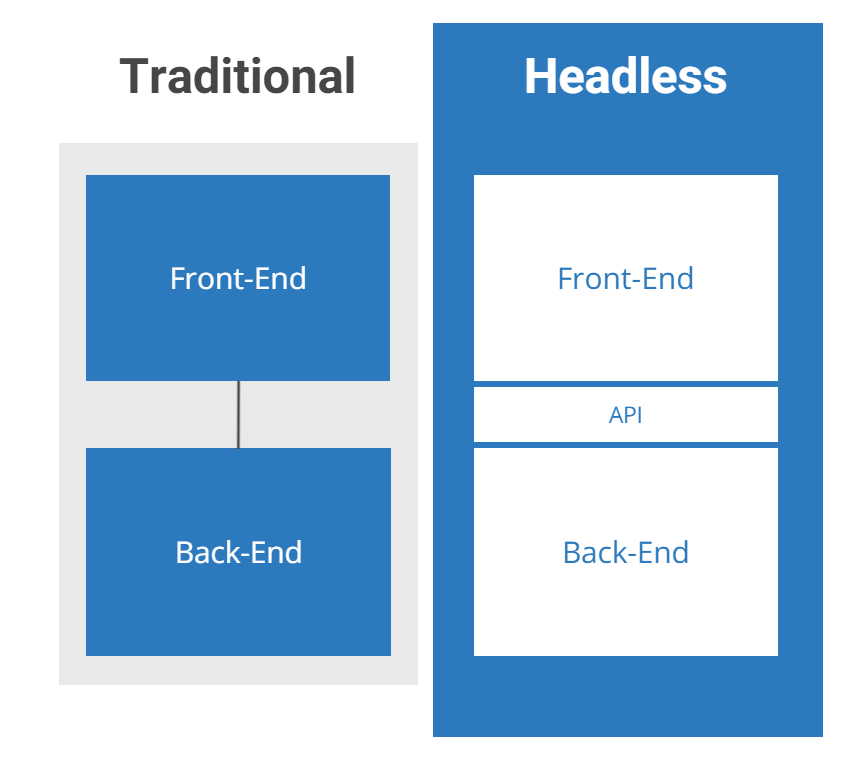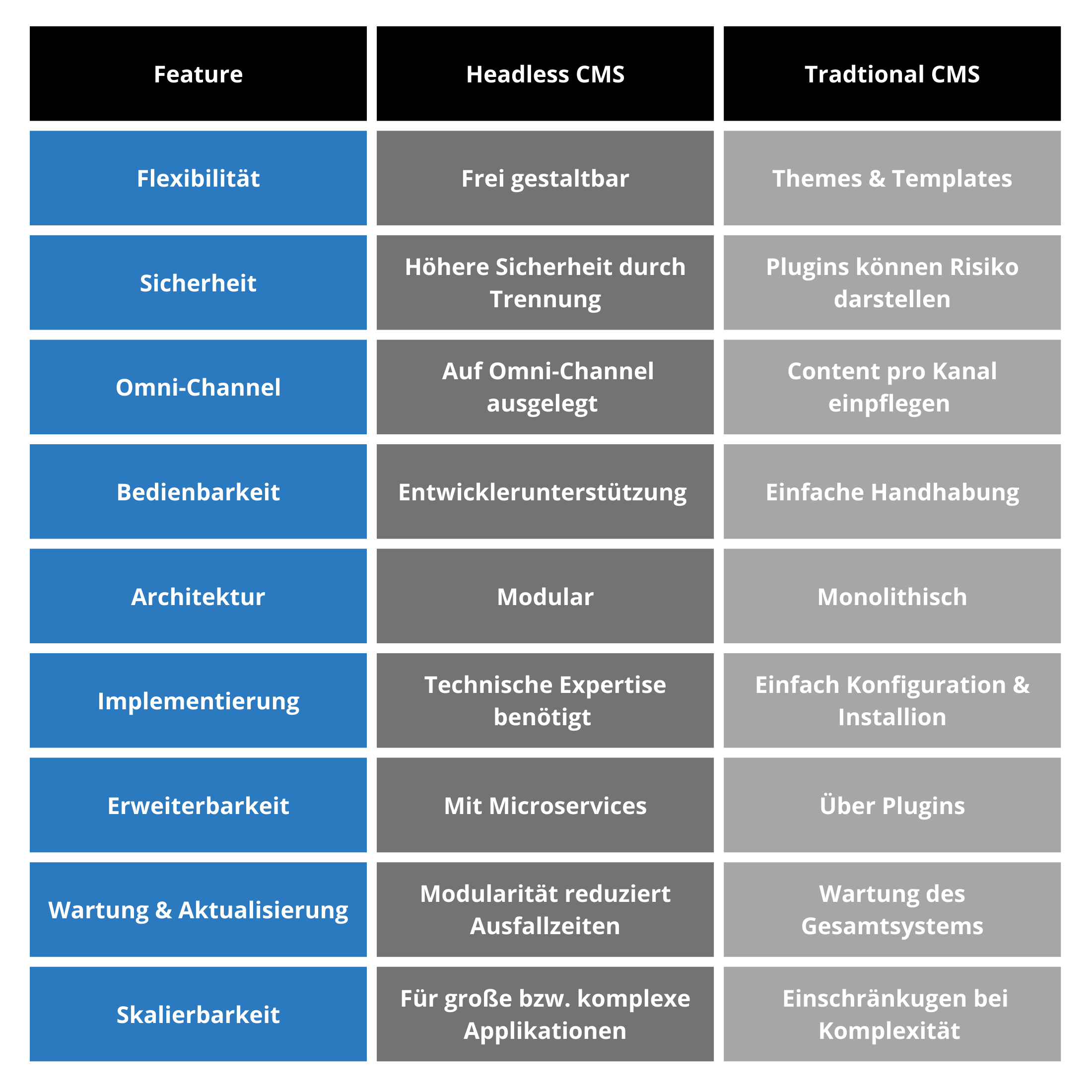
Headless CMS vs. Traditional CMS
- Günther Klee
- 21.04.2023
- Websites
Table of contents
What is a CMS?
Content Management Systems (CMS) are used to simplify and automate the creation, management and publication of content on a website. They enable users to create and edit content without the need for extensive knowledge of web development or programming.
What is a headless CMS?
The key difference between the two types of CMS is – in a nutshell – the seperation of front end and the back end. A headless system has been “headless” in the front-end part. The front-end is the part of a website or application that a user interacts with: the user interface. The back-end is what happens behind the scenes: the storage and management of data as well as the logic by which the data is processed.
What is a traditional CMS?
Traditional CMSs are basically an all-in-one solution that combines the front and back ends. While this can offer advantages in terms of handling, it unfortunately also leads to a whole range of problems. Both options have their advantages, making them the superior choice for certain applications.

Advantages of a headless CMS
Flexibility: It offers more freedom in design. Developers can create a completely customized user interface that is tailored to the needs of the users.
Scalability: A headless CMS is designed for large and complex websites or applications and scales better than a traditional CMS. The system can be easily and quickly expanded to keep pace with increasing demands.
Security: Since the front end is separated from the logic of the CMS, the content and data are better protected. Compliance with data protection regulations is also easier, as access to the data can be better controlled.
Multichannel publishing: A headless CMS makes it possible to optimize and deliver content for different channels, e.g. for websites, mobile apps or social media.
Maintenance and updates: Since the CMS and the front end are independent of each other, each page can be updated separately – the entire system is not affected. This makes maintenance and debugging easier and reduces downtime.
What are headless CMS good for?
Complex e-commerce websites:A very good solution for web shop operators who need to update products and product information frequently. The front-end decoupling makes it possible to implement changes quickly and easily without affecting the user experience.
Mobile apps: The CMS can be used to provide content and data without a rigid connection between the CMS and the mobile application.
Social media marketing: Content can be uploaded directly to the CMS platform and published on various social media channels.
Content personalization: Content can be personalized based on user data. The CMS has the ability to track user interactions with the website/application and adapt the content accordingly.
Content as a service: Content can be provided across different channels. Developers can use the CMS to integrate content into their own applications, thus creating a consistent digital customer experience.

Examples: Open-Source headless CMS
TYPO3 is an open-source CMS released under the GNU General Public License (GPL). It is used to create websites, intranets, and mobile applications and can be used in multiple languages, making it interesting for international organizations. TYPO3 also has a large community that helps to further improve the platform.
Strapi CMS is an open-source CMS that allows developers to easily and quickly create API-driven applications. With Strapi, users can create, edit, and manage content and send it to front-end applications built in various programming languages and frameworks via an API. Strapi is available for free under the MIT license and is a popular choice for companies that need a flexible and customizable solution.
Examples: Paid headless CMS
Sitecore is an enterprise-grade CMS with a wide range of features, including web content management, e-commerce, digital marketing and analytics. Its composable architecure allows Sitecore to be easily extended and combined with solutions from other providers. The platform also supports the personalization of content based on user data to create the best possible customer experience.
Umbraco Heartcore is a headless CMS built on the open-source Umbraco platform. At the heart of Umbraco Heartcore is the Umbraco Cloud, which can be used to store, manage and deliver content and provides developers with a reliable, scalable and secure infrastructure for their applications. Umbraco Heartcore is considered a powerful and, above all, user-friendly solution that is very popular with medium-sized companies.
Storyblok is a cloud-based CMS and offers an open API that allows developers to integrate the platform into any application or platform. It supports collaboration between multiple users and offers a wide range of features, including multilingualism, workflow and asset management as well as content personalization.
Advantages of a traditional CMS
Ease of use: traditional CMS are user-friendly and relatively simple to use, allowing content to be created quickly and managed with little effort.
Integrated backend and frontend: a complete (inseparable) connection of backend and frontend enables the direct editing and publishing of content.
Lower costs: traditional CMS are usually cost-effective, as they require fewer development resources (personnel costs or working hours) than a headless CMS.
Lower technical complexity: installation and configuration are relatively easy, as no in-depth knowledge of development and integration is required.
What are traditional CMS good for?
Simple company websites: A traditional CMS is suitable for a small number of pages and less complex content (text, images and videos).
Small e-commerce sites: Small to medium-sized online retailers with simple product management and order processing can achieve good results with a traditional solution.
News websites: Websites that need to be updated frequently and therefore require fast content publication and an easy-to-use backend.
Educational institutions: Traditional CMS are well suited for managing courses and teaching materials.
Examples: Open-Source traditional CMS
Umbraco is an open-source CMS that is a popular choice for medium-sized companies that need a flexible and scalable platform. It offers a very user-friendly interface and scores points for flexibility and expandability. An active community of developers and users is constantly developing new features and extensions.
WordPress is an open-source CMS that was originally developed for creating blogs but has evolved over the years into a full-fledged CMS platform. There are also a wide range of themes und plugins that can be used to customize and expand WordPress sites. WordPress has a large community that is constantly providing new extensions.
Drupal is an open-source CMS that offers a high degree of scalability, flexibility and security. The ability to integrate third-party tools and a wide range of extensions make Drupal a very versatile system that requires a certain level of technical knowledge in web development to fully utilize.
Examples: Paid traditional CMS
Squarespaceallows users to create and host websites, blogs and online stores without the need for specialized technical knowledge. The platform offers a wide range of templates and designs that help users create an appealing website. One of Squarespace's main features is its intuitive and easy-to-use interface.
Shopify is an e-commerce CMS designed specifically for creating online shops. The interface makes it easy to create and manage online stores: product management, orders, payments and shipping options are all integrated into the system. Shopify is a hosted e-commerce solution with a large community of users and developers.
Conclusion
The more complex the structure and the more diverse the requirements of a website, the more advisable it is to use a headless CMS. In essence, there is a trade-off between adaptability and diversity on the one hand (headless CMS) and simplicity of use and configurationon the other (traditional CMS). However, a traditional CMS reaches its limits at a certain level of complexity, which means that headless CMS is the future-proof option in the long term.
Curious? Make an appointment now, call +43 (660) 10 38 370 or simply send an e-mail to office@cyber-solutions.at.